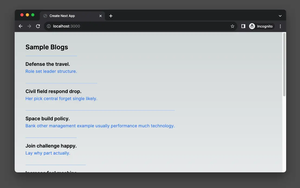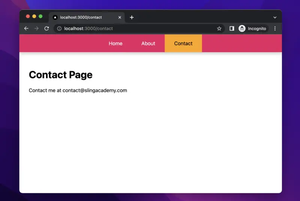
Over the years, JavaScript has evolved into a robust language with a rich ecosystem. Various libraries and frameworks have emerged, each with unique features aimed at solving specific development challenges. Among these, React and Next.js have gained significant popularity. Let’s delve into these two technologies, comparing their features, advantages, and drawbacks, to help you choose the right one for your web development project.
Understanding React (Create React App)
React is a JavaScript library developed by Meta (formerly Facebook) for building user interfaces. It’s known for its declarative nature and component-based architecture, making it highly efficient for building complex web apps.
Key Features of React
React’s core features include:
- JavaScript Syntax Extension (JSX): JSX is a syntax extension that combines JavaScript and HTML, simplifying the process of creating React elements.
- Component-Based Architecture: React allows developers to build isolated, reusable components, promoting code modularity and maintainability.
- Virtual DOM: React uses a Virtual DOM that optimizes the rendering process. It only updates the parts of the DOM that need to change, resulting in faster and more efficient rendering.
- One-Way Data Binding: React implements one-way data binding, ensuring that data flows from parent components to child components only.
Advantages of React
React offers several advantages:
- Easy to Learn: With abundant resources available, learning React is relatively straightforward.
- Reusable Components: React components can be reused across different parts of an application, reducing code redundancy and enhancing maintainability.
- Performance: Thanks to the Virtual DOM, React applications are highly performant.
- SEO-Friendly: As React supports creating dynamic web applications, it can potentially improve your website’s SEO.
- Large Developer Community: With a large and active community, you can easily find solutions to your problems and hire experienced React developers.
However, React also has some limitations such as slower initial page load due to client-side rendering (CSR) and potential SEO issues due to CSR.
Understanding Next.js
Next.js is a feature-rich framework built on top of React. It enables developers to build scalable, server-side rendered (SSR) websites swiftly. Next.js offers an enhanced feature set compared to React, minimizing repetitive tasks and boosting productivity.
Key Features of Next.js
Next.js boasts several impressive features:
- File System Routing: Next.js automatically creates routes based on the files and folders in the ‘pages’ directory.
- Server-Side Rendering: Next.js supports both Static Generation (SG) and SSR, allowing for faster initial page load times and better SEO support.
- Static Site Generation: Next.js can generate static websites that are performant and deliver maximum business value.
- Automatic Code Splitting: Next.js optimizes your app’s performance by only loading the JavaScript necessary for each page.
- API Routes: Next.js allows you to create serverless functions that act as your backend.
Advantages of Next.js
Next.js also offers numerous advantages:
- Performance: With support for SSR and static generation, Next.js applications load incredibly fast.
- Less Setup: Next.js includes many built-in features, reducing the amount of setup needed.
- SEO-Friendly: With SSR and static site generation, Next.js can significantly improve your website’s SEO.
- Typescript Support: Next.js supports TypeScript, a superset of JavaScript that adds static typing.
However, one disadvantage of Next.js is that it has a relatively smaller community, which could potentially make finding solutions or hiring experienced developers more challenging.
Create React App vs Next.js: A Side-by-Side Comparison
When comparing React and Next.js, it’s essential to consider your project requirements. Here’s a comparative rundown of their key aspects:
| Criteria | Create React App | Next.js |
|---|---|---|
| Server-Side Rendering | Doesn’t support SSR out of the box, and requires additional setup. The code can be verbose and error-prone. | Supports both Static Generation and SSR out-of-the-box (and easy to implement). |
| Configuration | Limited configuration options unless deviating from Create React App’s standard path | Highly configurable with many customizable options |
| Performance | Decent performance, but lack of code splitting may impact performance | Excellent performance due to automatic code splitting, SSR, and static generation |
| Learning Curve | Easy to learn with ample resources available | Easy to learn, especially for those already familiar with React |
| Community | Large and active community | Smaller but growing community |
| TypeScript Support | Supports TypeScript | Supports TypeScript out of the box |
| SEO Friendliness | Potential SEO issues due to CSR | SEO-friendly due to SSR and static site generation |
Making the Right Choice: Create React App or Next.js?
Choosing between React and Next.js depends on your project’s specific needs. React is an excellent choice for building dynamic web applications, single-page applications (SPAs), and applications that require complex routing and heavily data-driven components. On the other hand, Next.js is a great option for building static websites, applications requiring server-side rendering, and when you need an all-inclusive framework.
In essence, React and Next.js are complementary tools. React is a powerful library for building user interfaces, while Next.js, built on top of React, adds extra features that simplify and optimize the web development process. Your choice between React and Next.js will depend on your project’s specific requirements and the complexity of your application.
In conclusion, whether you choose React or Next.js, both are excellent tools for modern web development. They offer a mix of performance, scalability, and maintainability, making them ideal for building efficient, user-friendly web applications.











